A Guide to Our Scientific Terms
Since CABBI’s inception in 2017, hundreds of scientists at partner institutions across the country have collaborated on developing efficient ways to grow bioenergy crops, transform plant biomass into valuable chemicals, and market the ecologically and economically sustainable biofuels and other products that result.
The terminology used in this work can look a little bit like “alphabet soup” to the casual observer. On this webpage, we define the vocabulary and explain its significance to our mission — and put it in further context with photos, illustrations, and links to real-world examples. We have divided our ABCs into four groups: Bioenergy Basics; On the Farm; In the Lab; and Tools.
Terms are searchable using Control+F.

Bioenergy Basics: Defining Our Vision and Research Mission
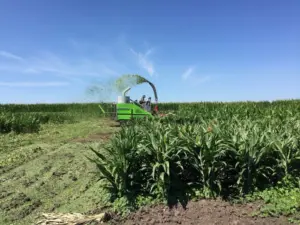
Agronomics: Short for “agricultural economics,” the branch of economics dealing with the distribution, management, and productivity of land. CABBI teams hope to use advances in agronomics and other disciplines to increase the value of energy crops and produce sustainable biofuels and biochemicals, reducing dependence on fossil fuels.
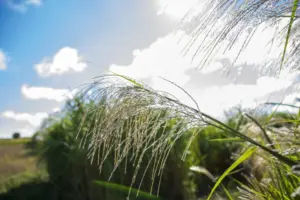
Bioeconomy: Economic activity that uses renewable biological resources, such as crops, forests, fish, animals and micro-organisms, to produce food, materials and energy. CABBI’s research supports a resilient bioeconomy.

Biofoundry: Short for biological foundry, a factory that can design, build, and test genetic products, often with robotics or new technology platforms, to accelerate and prototype bioengineering applications. The Illinois Biological Foundry for Advanced Manufacturing (iBioFAB) is an example, employed by researchers to speed up repetitive processes used to screen yeast cells and other components. (See definition for “iBioFAB” in the Tools section below.)

Biorefinery: A facility that integrates conversion processes and equipment to produce fuels, power, and value-added chemicals from biomass. It’s analogous to current petroleum refineries, which produce fuels and other products from petroleum. The University of Illinois Integrated Bioprocessing Research Laboratory (IBRL) helps test processes to be scaled up for a biorefinery, processing biomass from CABBI feedstocks into oil, sugar, and other components used for fuel. CABBI Sustainability researchers also analyze the economics, productivity, and environmental impact of biorefineries for potential bioproducts and biofuels.
(See definitions for “IBRL” in the On the Farm section and “BioSTEAM” under Tools below.)
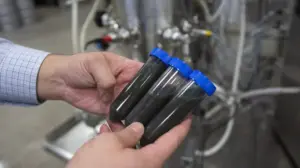
Biofuel: A fuel derived from plant biomass as opposed to fossil fuels (e.g., petroleum) that emit harmful greenhouse gases like carbon dioxide (CO2). Biofuels are considered net zero emitters: The CO2 they emit when burned is balanced by the carbon dioxide they use for their growth. Biodiesel and bioethanol are first-generation (“conventional”) biofuels, produced from food crops rich in fermentable carbohydrates. Second-generation (“advanced”) biofuels are extracted from grasses and residues of food crops. CABBI researchers focus on miscanthus, sorghum, sugarcane, and energycane to produce sustainable biofuels.

Biomass: A renewable organic material derived from plants (e.g., leaves and stems) or animals. Biomass can be burned directly for heat or converted to renewable liquid and gas fuels. Examples include firewood, switchgrass, and sugar. CABBI Feedstock teams use biomass from sorghum, miscanthus, and sugarcane for their research on sustainable biofuels.
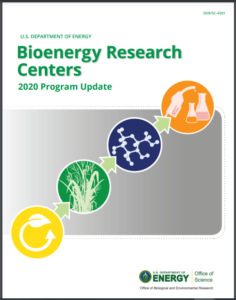 Bioenergy Research Center (BRC): CABBI is one of four BRCs established by the Department of Energy’s (DOE) Genomic Science program, within the DOE Office of Science’s Office of Biological and Environmental Research. With the shared mission to break down the barriers to a domestic bioenergy industry, the centers — each led by a DOE national laboratory or top university ‚ take distinctive approaches toward a common goal of scaling up the production of advanced biofuels and bioproducts.
Bioenergy Research Center (BRC): CABBI is one of four BRCs established by the Department of Energy’s (DOE) Genomic Science program, within the DOE Office of Science’s Office of Biological and Environmental Research. With the shared mission to break down the barriers to a domestic bioenergy industry, the centers — each led by a DOE national laboratory or top university ‚ take distinctive approaches toward a common goal of scaling up the production of advanced biofuels and bioproducts.
Besides CABBI, the other BRCs are the Joint Bioenergy Institute (JBEI), the Center for Bioenergy Innovation (CBI), and the Great Lakes Bioenergy Research Center (GLBRC).
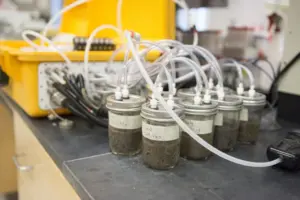
Carbon cycling: The process in which land and ocean ecosystems absorb and sequester (or capture and store) carbon dioxide emitted from the burning of fossil fuels and other activities, thus limiting the increase of CO2 in the atmosphere. Deforestation and permafrost melt in the Arctic hamper this process. CABBI researchers study how plant ecosystems use and sequester carbon as they identify the most sustainable ways to produce biofuels and bioproducts.
Computational biology: The science of using biological data to develop models or algorithms to understand biological systems. CABBI teams use computational biology to design new tools for studying how yeasts produce lipids and ways to improve them, or for understanding what yeast proteins do inside the cell so they can apply that to the design of synthetic yeasts.
Read how Ph.D. Candidate Anshu Deewan uses computational biology in her CABBI research.
Ecosystem: A biological community of interacting organisms and their physical environment — everything from soil microbes to mammals. To assess the sustainability and productivity of potential bioenergy crops, CABBI researchers study anything that affects the plants and their impact on the soil, water, and broader ecosystem.
Ecosystem services: The benefits provided by ecosystems, including food, water, timber, fuel, and recreation, as well as regulating systems that affect climate and water quality and support services such as soil formation, photosynthesis, and nutrient cycling. CABBI researchers study those services to assess the sustainability of bioenergy crops. (See definition of “ecosystem” in this section.)
Genome: An organism’s complete set of DNA, including all of its genes. Understanding a plant’s genome allows researchers to design new types of yeasts or plants that can produce abundant biofuels and bioproducts. A CABBI-led team sequenced the full genome of the perennial grass Miscanthus sinensis, providing a road map for scientists exploring the genetic basis for the bioenergy crop’s desirable traits. And researchers at Penn State are leading projects to build genome-scale models for two yeasts, Rhodosporidium toruloides and Issatchenkia orientalis.
Learn more about CABBI’s work on the miscanthus genome.
Read our press release outlining Penn State’s genome modeling research.
Genomics: An interdisciplinary field of biology focusing on the structure, function, evolution, mapping, and editing of a genome, including how genes interact with each other and with their environment. Scientists in CABBI’s Feedstock Production and Conversion Themes apply genomics to their research on plants and yeasts.(See related definition for “genome editing” under the In the Lab section below.)
in planta, in silico: Research or experiments performed in the field (in planta) or via computer simulation (in silico). CABBI Feedstock Production teams use both approaches in their work to design plants that can synthesize biofuels, bioproducts, and helpful molecules directly in their stems.
Life cycle assessment (LCA): A method used to evaluate a product’s environmental impact through its life cycle, encompassing extraction and processing of the raw materials, manufacturing, distribution, use, recycling, and final disposal. CABBI Sustainability researchers have developed BioSTEAM and BioSTEAM-LCA, tools to greatly improve LCA and techno-economic analysis (TEA) of biorefineries. (See related definitions in this section and under Tools below.)
Lipids: A class of organic compounds that are fatty acids or their derivatives and are insoluble in water. Lipids include many natural oils, waxes, and steroids. CABBI teams are working to increase the amount of lipids produced in plant stems and other vegetative tissues to create renewable biofuels and biochemicals from perennial grasses.
Metabolic engineering: The process of optimizing genetic and regulatory processes within cells to increase the production of a certain substance, often by redirecting enzyme reactions to produce new compounds or improve the production of existing ones. CABBI teams use metabolic engineering to develop robust strains of tiny yeasts that can convert renewable plant biomass to biodiesel, jet fuels, organic acids and other biochemicals, as a sustainable alternative to petroleum-based chemical manufacturing processes.
Read about new tools developed by CABBI researchers to facilitate metabolic engineering in yeasts.
Synthetic biology: A field of science that involves redesigning organisms such as enzymes or cells by engineering them to have new abilities. At CABBI, researchers are designing new yeasts and feedstocks to produce fuels and chemicals from renewable sources.
Techno-economic analysis (TEA): A framework to assess the overall value of a process considering the costs, benefits, risks, uncertainties, and time frames involved, including such factors as the raw materials, processing costs, and product disposition. (TEA normally combines process modeling, engineering design, and economic evaluation.) CABBI Sustainability researchers have developed the “BioSTEAM” tools for TEA and life cycle assessment (LCA) of biorefineries. (See related definitions in this section and “BioSTEAM” under Tools below.)
On the Farm: Cultivating and Refining CABBI’s Bioenergy Crops
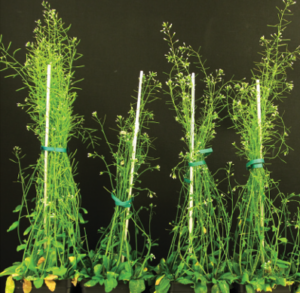
Arabidopsis: A small flowering plant in the mustard family commonly used as a model for genetic researchers, including at CABBI. It’s easy and inexpensive to grow; has a comparatively small genome, simplifying genetic analysis; and produces many seeds, allowing extensive experiments with tens of thousands of plants. It also develops, reproduces and responds to stress and disease in much the same way as many crops.
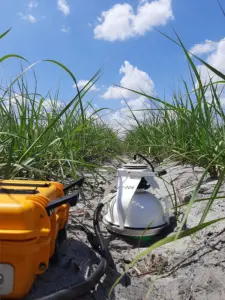
Archbold Biological Station: An independent not-for-profit organization in the critical headwaters of the Florida Everglades and an internationally recognized center for research, conservation, and education. Archbold manages Buck Island Ranch, a 4,251-hectare, 3,000-head commercial cattle ranch that is a living laboratory for agroecological research. The primary research goal is to understand relationships among agricultural production and natural resources including water, soil, and biodiversity and addressing threats such as diseases, invasive species, land use change/intensification, and climate change/variability.

Bagasse: The dry, pulpy fiber residue left after sugarcane or sorghum stalks are crushed to extract their juice. It is used as a biofuel for the production of heat, energy, and electricity, and in the manufacture of pulp and building materials. The feedstocks cultivated at CABBI, such as sugarcane and oilcane, are processed at the Integrated Bioprocessing Research Lab to separate the juices from the dry bagasse. The goal of a biorefinery is to use all aspects of a bioenergy feedstock, including bagasse, while minimizing waste.
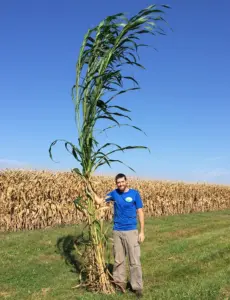
Bioenergy/biomass sorghum: A hybrid sorghum species favored for bioenergy crops and a key target for CABBI researchers. This annual C4 grass does not produce grain but has abundant leaves and stems, or biomass. It’s a popular biofuel feedstock because of its drought tolerance, short growing season compared to miscanthus and other perennials, and ability to produce large plants with less fertilizer and crop management. CABBI researchers discovered that energy sorghum behaves more like miscanthus, a perennial, in terms of its water use and carbon cycling while still offering the flexibility of an annual crop — boosting its potential as a sustainable bioenergy crop.

C4 grasses: Plants used as targets by CABBI researchers developing new bioenergy crops. The terms C4 and C3 refer to the pathways that the plants use to capture carbon dioxide during photosynthesis. C4 plants include perennial grasses like miscanthus and sugarcane, as well as maize, an annual crop, and sorghum, which can be either annual or perennial depending on the variety. CABBI researchers are focusing on sorghum, sugarcane, energy cane, and miscanthus, all high-yielding grasses that grow throughout the rain-fed eastern United States, including on marginal soils. (See related definitions for those crops in this section.)
Cellulose: A major component of a plant’s cell walls, along with lignin and hemicellulose, which help maintain the structural integrity of stems, leaves, and other plant structures. Cellulose is a carbohydrate with large reservoirs of energy that provide potential for conversion into biofuels. (See related definitions for “lignocellulose” and other terms in this section.)
Cellulosic ethanol production: A process that breaks down the cell walls of plant material to release the starch or sugars in the leaves and stems. These simpler compounds are then fermented into ethanol. CABBI researchers work with several plants that hold potential as cellulosic bioenergy crops, including energy cane. (See definitions for those energy crops in this section.)
Energycane: Hybrids of sugarcane that have been selected for high biomass, high fiber, and low concentration of sucrose (the chief component of cane sugar). Due to its generous biomass and non-invasiveness, energycane has strong potential to be considered as a feedstock for cellulosic ethanol production.

Flux: By definition, the flow of a substance or property. At CABBI, fluxes are used to track how water, carbon dioxide, nitrogen, and energy move between plants and the atmosphere — the “breathing” of an ecosystem. A carbon flux, for example, measures the amount of carbon exchanged between Earth’s carbon pools — the oceans, atmosphere, land, and living organisms like plants and animals. This work can help determine the sustainability potential of various bioenergy crops.
Read how CABBI researchers use flux data to compare bioenergy sorghum to other crops.
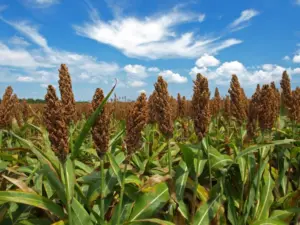
Grain sorghum: A type of sorghum grass grown as an annual feed grain, similar in appearance to corn but with more tillers (grass shoots) and finely branched roots and smaller seeds. Its growth and development are similar to corn and other cereals. CABBI researchers focus on a different hybrid — bioenergy/biomass sorghum — in their research.
Hemicellulose: A polysaccharide — a carbohydrate made up of sugar molecules bonded together — and a key structural component of the cell wall of plants, along with cellulose and lignin. Hemicellulose has a simpler structure than cellulose. (See related definitions for “lignocellulose” and other terms in this section.)
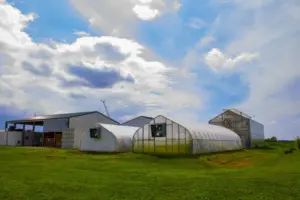
Illinois Energy Farm: A 320-acre farm at the University of Illinois Urbana-Champaign used as a “living laboratory” by CABBI researchers and other scientists. CABBI teams grow varieties of sorghum, miscanthus, and sugarcane in their work to develop sustainable biofuels.
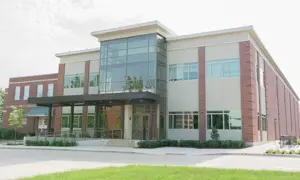
Integrated Bioprocessing Research Laboratory (IBRL): A bioprocessing product research and development facility at the University of Illinois Urbana-Champaign that bridges the gap from basic discovery to commercialization of bioproducts. CABBI teams use IBRL to process sorghum, oilcane, and other bioenergy crops into oil, sugar, and other components used for fuel.
Lignin: A complex, oxygen-containing compound that is a key component of the cell wall of plants. With cellulose, lignin forms the chief constituent of wood, acting as a natural “glue.” It also plays an important role in conducting water within the vascular cells in plant stems. It is second only to cellulose as the most abundant organic material on Earth, though it has relatively few industrial uses other than as a fuel. (See related definitions for “lignocellulose” and other terms in this section.)
Lignocellulose: A generic term for describing the main constituents in most plants — namely, cellulose, hemicelluloses, and lignin. Lignocellulose is a complex mix of proteins, polymers, and polysaccharides (or polycarbohydrates). Lignocellulosic biomass consists of a variety of materials with distinctive physical and chemical characteristics; it is the non-starch based fibrous part of plant material. Compared with the production of ethanol from first-generation feedstocks, the use of lignocellulosic biomass is more complicated because the polysaccharides are more stable and the pentose sugars are not readily fermentable by the yeast Saccharomyces cerevisiae. CABBI Conversion researchers are engineering several yeasts to produce biofuels and chemicals from lignocellulose derived from CABBI feedstocks. (See related definitions for the cell wall components in this section and yeasts under In the Lab below.)
Miscane: A cross between sugarcane and miscanthus (Saccharum hybrid × Miscanthus spp.). This cross breeding was originally focused (decades ago) on transferring disease resistance genes from miscanthus to sugarcane, primarily in Southeast Asia.
Miscanthus (M. sinensis): A C4 perennial grass and key bioenergy crop used in CABBI research. Its relatively low maintenance and high yield/energy content play an important role in the sustainable production of renewable fuels and chemicals. Originating in Asia, the genus Miscanthus comprises about 17 species of perennial, rhizomatous tall grasses native to subtropical and tropical regions. The plant’s rhizome, or underground stem, allows it to store nutrients over the winter and therefore require less fertilizer. CABBI scientists led a successful international effort to sequence the full genome of M. sinensis. A key miscanthus hybrid used in CABBI research is Miscanthus x. giganteus. (See definitions for other bioenergy crops and miscanthus types in this section.)
Learn how a CABBI team sequenced the Miscanthus sinensis genome.
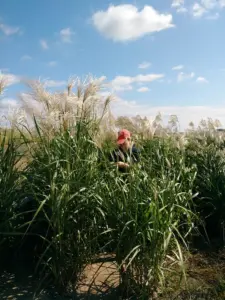
Miscanthus x giganteus (Mxg): A sterile hybrid of Miscanthus sinensis and Miscanthus sacchariflorus. It can grow to heights of more than 4 meters (13 feet) in one growing season. CABBI researchers study “Illinois type” grown at the Illinois Energy Farm. Also known as miscanthus giganteus, giant miscanthus, or elephant grass.
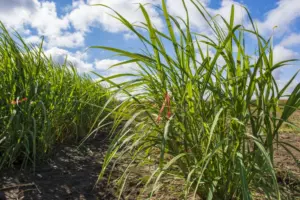
Oilcane: A variety of sugarcane engineered to divert natural sugars for oil production, as a sustainable alternative to petroleum-based fossil fuels. A groundbreaking CABBI project developed new lines of oilcane with elevated lipid content, cultivated them in the lab and greenhouse, conducted field trials in three states, then harvested and processed the crops into oil (for biodiesel), sugar (for bioethanol), and bagasse — the dry, pulpy material left over that can be used for fuel or building materials.
Learn more about CABBI’s oilcane “pipeline” project in this news release and video.
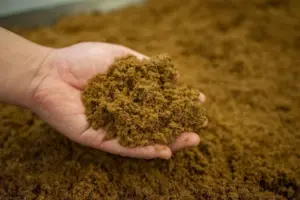
Pretreatment: As in biomass pretreatment, the process of physical, biological, or chemical breakdown of lignocellulosic biomass. Hydrothermal pretreatment involves loading raw biomass into a reactor and “treating” it with hot steam, opening up the plant structure and separating out the useful components. (See related definitions for “lignocellulosic biomass” in this section and “enzymatic hydrolysis” under In the Lab below.)
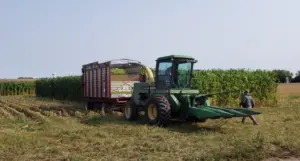
SABR Farm: The Sustainable Advanced Bioeconomy Research Farm at Iowa State University in Ames, Iowa, one of three CABBI field sites. CABBI researchers use the farm to quantify the exchange of water, energy, nutrients, and greenhouse gases for the energy crops miscanthus and biomass sorghum and compare them to corn and soybeans.
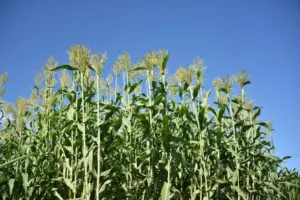
Sorghum (sorghum bicolor): A wild perennial grass that reaches heights up to 12 feet, favored as a model for the design of C4 grass bioenergy crops. Plants can be annual or perennial, depending on the varieties, which include grain sorghum, sweet sorghum, and biomass/bioenergy sorghum. Sorghum bicolor is the cultivated species of sorghum. Annual energy sorghum hybrids serve as a source of biomass for bioenergy production, including at CABBI. Hybrids with long vegetative growth phases accumulate more biomass than grain sorghum because of their extended growing seasons, greater light interception, and higher solar radiation-use efficiency. (See definitions for other bioenergy crops and sorghum types in this section.)

SoyFACE: The Soybean Free Air Concentration Enrichment facility at the University of Illinois Urbana-Champaign. This innovative facility is used for growing crops under production field conditions in an atmosphere that has higher levels of carbon dioxide and ozone, higher temperature, and altered soil water availability. SoyFACE was designed to discover the effects of atmospheric change on the agronomy and productivity of Midwestern crops and develop crops better adapted to this future. CABBI scientists are using SoyFACE to test the tolerance of diverse miscanthus lines to elevated ozone.
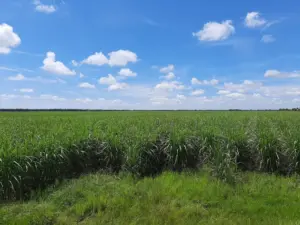
Sugarcane (Saccharum spp.): A large C4 perennial grass used in CABBI’s bioenergy research. Sugarcane is cultivated in the tropics primarily for its high sugar (sucrose) content but more recently is seen as a source of biomass for alternative fuels. Hybrids include energy cane, bred for high biomass to be used for cellulosic ethanol production; and oilcane, engineered to divert natural sugars for oil production. (See definitions for C4 grasses, other bioenergy crops, and sugarcane types in this section.)

Sweet sorghum: One of the many varieties of sorghum grass whose stalks have a high sugar content. It’s grown primarily for forage, silage, and syrup production, though it can be used as a biofuel feedstock. CABBI researchers use a different hybrid, bioenergy/biomass sorghum, in their research.
In the Lab: Engineering Plant, Microbes, and Products
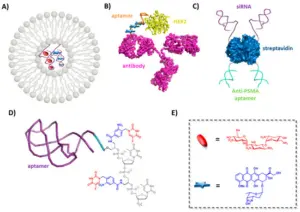
Aptamer: A short, single-strand oligonucleotide, or peptide, that binds to a specific target molecule, often used in medical imaging, diagnosis, and drug delivery systems. Fluorescent aptamers are used by CABBI researchers as sensors to monitor metabolites in living cells, with potential metabolic engineering applications for the production of bioproducts.

Citramalate: An organic acid and one of CABBI’s five target bioproducts. It’s a platform, or intermediate, chemical that can be converted into valuable compounds such as MMA/PMMA (methylmethacrylate or polymethylmethacrylate) — lightweight, transparent, shatter-resistant materials for eyeglasses, mobile phones, and other electronics. CABBI Conversion researchers are engineering yeasts to help convert plant material into sustainable biofuels and biochemicals such as citramalate. (See related definition in this section for Issatchenkia orientalis.)
Enzymes: Proteins in living organisms that catalyze, or speed up, chemical reactions. Enzymatic biocatalysis is emerging as a way to synthesize valuable compounds, using natural enzymes to act on specific substrates and create target products. One goal within synthetic biology, and at CABBI, is to engineer new enzymes that catalyze novel reactions for which enzymes do not currently exist. (See related definition for “photocatalysis” in this section.)
Enzymatic hydrolysis: A process in which enzymes facilitate the cleavage of bonds in molecules with the addition of the elements of water. It plays an important role in the digestion of food and is also used to help process crops into renewable fuels, as with cellulosic ethanol. (See related definition for “pretreatment” in On the Farm above.)
Fatty acid: A chemical structure consisting of a chain of hydrocarbons with a carboxyl group attached to one end. Hydrocarbon chains vary widely in length and may be saturated or unsaturated. Fatty acids are crucial components of biodiesel fuel, fatty alcohols, waxes, and olefins (building blocks for soaps and adhesives). CABBI Conversion teams genetically engineer tiny yeast cells to increase production of fatty acids so those chemicals can be made from renewable plant biomass instead of petroleum.

Fatty alcohols: Long-chain alcohols and one of CABBI’s five target bioproducts. Fatty alcohols, such as decanol or octonol, can be upgraded into diesel fuel for jets or gasoline engines as well as other products, including detergents, surfactants, skin-care products, and cosmetics. CABBI Conversion researchers are engineering yeasts to help convert plant material into sustainable biofuels and biochemicals such as fatty alcohols. (See related definitions in this section for Rhodosporidium toruloides and Yarrowia lipolytica.)
Genome annotation: The process of identifying all genes and coding regions in a sequenced genome, a necessary step for CABBI researchers and others in interpreting genome sequencing data for plants or microbes.
Genome editing: A method of experimentally altering the genome of an organism by adding, deleting, or changing the DNA sequence. CRISPR is an example of a commonly used genome editing method. CABBI scientists have used genome-editing to improve productivity in plants or engineer new strains of yeasts in their mission to produce biofuels, organic acids, and other valuable bioproducts. (See related definition for “CRISPR/Cas9” in The Tools section below.)

3-Hydroxyproprionic acid (3-HP): An organic acid and one of CABBI’s five target bioproducts. It’s a platform, or intermediate, chemical that can be converted into valuable compounds found in everyday products — for example, acrylic acid, which is used to make coatings, adhesives, and oil treatment chemicals and promote absorbency in diapers. CABBI Conversion researchers are engineering yeasts to help convert plant material into sustainable biofuels and biochemicals such as 3-HP. (See related definition in this section for Issatchenkia orientalis.)

Issatchenkia orientalis (I. orientalis): One of four yeasts targeted by CABBI Conversion researchers to help convert plant material into sustainable biofuels and biochemicals. It is a non-model yeast, or one that has not been extensively studied. Tolerant of low pH, I. orientalis is being explored as an engineering candidate for the production of two organic acids, 3-HP and citramalate, precursors to valuable chemicals used in everyday products. Citramalate can be upgraded to lightweight, transparent, shatter-resistant materials used in eyeglasses, mobile phones, and other electronics; 3-HP has applications for diapers, surfactants, adhesives, sealants and more. CABBI is also developing genetic manipulation tools for this yeast.
Learn how researches developed a genetic toolkit for metabolic engineering of I. orientalis.
Medium-chain fatty acids (MCFAs): Fatty acids with fewer than 12 carbon chains, which are desirable but less abundant naturally. MCFAs are the building blocks for soaps, industrial chemicals, and fuels, typically made from petroleum. CABBI teams are engineering yeasts to produce MCFAs from renewable biomass in their research to develop more sustainable bioproducts.
Metabolome: The collection of small-molecule chemicals present within a biological sample. It includes the endogenous (internal) metabolome, consisting of biological molecules synthesized by the organism (sugars, nucleotides, amino acids, and lipids); and the exogenous (external) metabolome, which includes other compounds which are absorbed or derived from the organism’s environment.
Microbiome: The community of microbes (bacteria, fungi, etc.) that live on or inside plants and play key roles in plant health and productivity. One goal at CABBI is to understand microbiomes and their effect on bioenergy crop traits and sustainability.
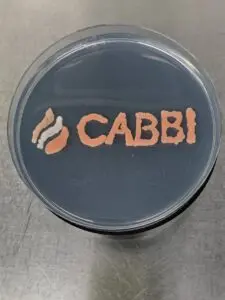
Oleaginous yeast: A classification for a group of yeast species that can produce oil and accumulate it in lipid bodies within their cells. CABBI researchers are using two oleaginous yeast species in their work to produce renewable fuel and bioproducts from plant material: Rhodosporidium toruloides and Yarrowia lipolytica. (See related definitions for those species in this section.)
Oleochemicals: Products derived from vegetable or animal oils and fats (as opposed to petrochemicals made from petroleum or natural gas). Examples include soaps, lubricants, fatty acids, and fatty alcohols. CABBI’s research is aimed at using synthetic biology to make more of those compounds from renewable resources.
Read about CABBI Postdoc Qiang Yan’s work on oleochemical production in yeast.
’omics (alternatively known as Omits): The collection of fields of study in biology ending in “-omics,” including genomics (the study of genomes; definition in the Bioenergy Basics section), proteomics, transcriptomics, lipidomics, and glycomics.
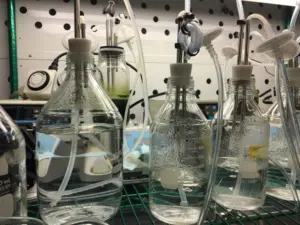
Organic acid: Technically any organic compound with acidic properties. In CABBI, this term is generally used interchangeably with carboxylic acid, to refer to organic molecules that contain one or more carboxyl (-COOH) groups, such as succinic, muconic, lactic, adipic, propionic, butanoic, fumaric, or fatty acids. CABBI researchers are using yeasts to convert material derived from plants into useful organic acids, crucial components in fuel, soaps, and adhesives, among other products.
Read about a new project by CABBI researchers to produce organic acids directly in plants.
Photocatalysis: A process that uses light as a catalyst to spur a chemical reaction, as opposed to enzymatic or chemical catalysts. All organisms rely on chemical reactions to make various natural products, and scientists often use a combination of catalysts to produce higher yields, as in the production of biofuels and pharmaceuticals. CABBI researchers have developed a method that combines photocatalysis with enzymatic catalysts to aid production of valuable compounds.
Proteome: The set of expressed proteins in a given type of cell or organism at a given time under defined conditions. Proteomics is the large-scale study of proteins. A CABBI team is designing tools to better understand how proteins, which govern cell function, are regulated in natural yeasts so they can design synthetic versions to use in their bioenergy research.
Read more about CABBI researcher Meera Gupta’s work on yeast proteins.
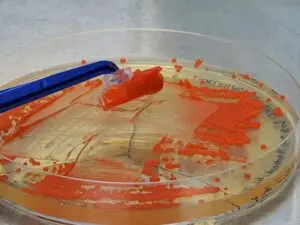
Rhodosporidium toruloides (R. toruloides — alternatively known as Rhodotorula toruloides): One of four yeasts targeted by CABBI Conversion researchers to help convert plant material into components for sustainable biofuels and biochemicals. R. toruloides is a non-model yeast, or one that has not been extensively studied. This fast-growing, oleaginous yeast is a promising candidate for engineered lipid, or oil, production because of its ability to synthesize fatty acids. CABBI uses R. toruloides to process triacetylglycerides (TAGs), plant-derived lipids used in diesel fuel and surfactants; and to make fatty alcohols (detergents, cosmetics, skin-care products, jet fuel) and acetyl-CoA, a precursor for triacetic acid lactone (food preservatives, flavoring agents, plastics).
Rubisco: An enzyme involved in the first major step of carbon fixation, a process by which atmospheric carbon dioxide (CO2) is converted by plants and other photosynthetic organisms to energy-rich molecules such as glucose. It evolved when no oxygen was present in the atmosphere, and its presence now causes plants to burn off carbon and waste energy. C4 grasses developed a way to contain rubisco, improving their efficiency and allowing them to fix CO2 with less water and nitrogen — desirable traits for bioenergy crops.
Learn more about rubisco in this video from our Bioenergy 101 series, “Why C4 grasses?”
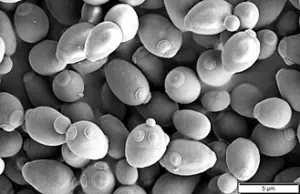
Saccharomyces cerevisiae (S. cerevisiae): One of four yeasts targeted by CABBI Conversion researchers to convert plant material into sustainable biofuels and biochemicals. S. cerevisiae has been used for centuries in winemaking, baking, and brewing, as well as for industrial fermentation. One of the most intensively studied eukaryotic model organisms in molecular and cellular biology, it’s being explored in CABBI for developing new techniques and producing alcohol and fatty acids. Its conduciveness to genetic manipulation makes it a prime candidate for metabolic engineering.
Read about CABBI researchers’ work on fatty acid production in S. cerevisiae.

Triacetic acid lactone (TAL): One of CABBI’s five target bioproducts and a platform chemical that can be converted into valuable compounds used as food preservatives, flavoring agents, plastics, and more. Sorbic acid, the main product derived from TAL, is a food preservative widely used in wines, cheeses, baked goods, refrigerated meats, and canned goods. CABBI Conversion researchers are engineering yeasts to help convert plant material into sustainable biofuels and biochemicals such as TAL. (See related definition in this section for Rhodosporidium toruloides.)

Triacylglycerides (TAG): Esters derived from glycerol and three fatty acids and one of CABBI’s five target bioproducts. Energy-rich TAGs, also known as triglycerides, are the main storage form of fat in many living organisms. These compounds are split into their components during the manufacture of biodiesel; the resulting fatty esters can be used as fuel in diesel engines. The glycerin can be used in the manufacture of food and pharmaceuticals. TAGs also serve as a substrate for conversion into lubricants and surfactants for shampoo and other products. CABBI teams are working to improve TAG production and storage in plants — and to engineer yeasts to help process TAG. (See related definitions in this section for Rhodosporidium toruloides and Yarrowia lipolytica.)
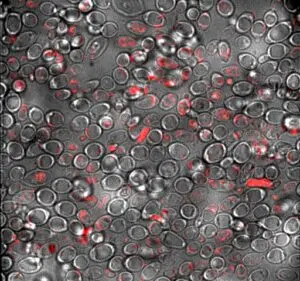
Yarrowia lipolytica (Y. lipolytica): One of four yeasts targeted by CABBI Conversion researchers to help convert plant material into components for sustainable biofuels and biochemicals.Y. lipolytica is a non-model yeast, one that has not been extensively studied. As an oleaginous yeast, it produces abundant oil and can be engineered to convert plant lipids into high-value products. CABBI uses Y. lipolytica to process triacetylglycerides (TAGs), plant-derived lipids used in diesel fuel and surfactants; and to make fatty alcohols (detergents, cosmetics, skin-care products, jet fuel) and acetyl-CoA, a precursor for production of triacetic acid lactone (food preservatives, flavoring agents, plastics).

Yeast: A single-celled eukaryotic fungus found all over the world — on plants, fruits, flowers, and soil. It’s been used for centuries for fermentation and leavening. Yeasts turn sugars into alcohol and carbon dioxide (CO2) through fermentation, chemically breaking down plants or other substances. The alcohol is used for beer, wine, or fuel; yeast is also used as a leavening agent to make dough rise. Some oleaginous yeasts, such as Rhodosporidium toruloides or Yarrowia lipolytica, can metabolize or store oil (see related definitions in this section).
Yeast is the perfect method to convert plant sugars and lipids into CABBI’s valuable target molecules. Crucial enzymes needed to catalyze, or speed up, that process are already built into its metabolism. Scientists can use yeast enzymes to act on specific substances and create target bioproducts. Yeasts also have higher tolerance for organic acids and other fermentation inhibitors found in plant cell walls during processing.
The Tools: Systems, Models, and Methods Supporting CABBI’s Mission
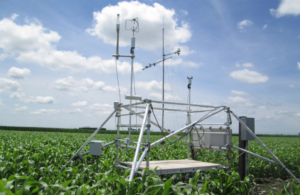
Ameriflux: A grassroots network of sites using eddy covariance to measure ecosystem CO2, water, and energy fluxes in North, Central and South America. It was established to connect research on field sites representing major climate and ecological biomes, including tundra, grasslands, savanna, crops, and conifer, deciduous, and tropical forests. The Illinois Energy Farm hosts an AmeriFlux site covering switchgrass, miscanthus, a maize-soy rotation, and restored prairie. CABBI scientists use Ameriflux data to measure crop performance and sustainability and to design tools to help researchers in that effort. (See related definition for “eddy covariance” in this section.)

Agro-IBIS: A comprehensive model of land surface and ecosystem processes; IBIS stands for Integrated Biosphere Simulator Model. Agro-IBIS simulates the energy, water, carbon, and momentum balance among the soil, vegetation and atmosphere in Midwest ecosystems — both natural forests and grasslands — as well as corn, soybean, and wheat crops, including terrestrial carbon and nitrogen cycling. The model accounts for agricultural management and the effects of environmental stressors on crop development and water balance. CABBI Sustainability researchers are using Agro-IBIS to understand how bioenergy crops could be managed to reduce nitrogen runoff in the Mississippi River system, which is blamed for the hypoxic “dead zone” in the Gulf of Mexico.
Read how CABBI’s Kelsie Ferin uses Agro-IBIS in her research on nitrogen runoff.
BEPAM: The Biofuel and Environmental Policy Analysis Model, which integrates the agricultural and transportation sectors of the U.S. economy and world fuel markets. BEPAM can determine the equilibrium prices, production, and consumption levels of transportation fuels, crop and livestock products, and the implied regional land allocation among row crops and perennial grasses for alternative biofuel policy scenarios. It’s one of several models used by CABBI’s Sustainability researchers to assess the economic and environmental sustainability of bioenergy crops and their impact on land use, agricultural producers, food and fuel prices, consumers, and climate.
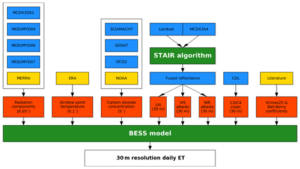
BESS-STAIR: A high-resolution mapping framework developed by CABBI researchers to provide accurate forecasts of crop water use on a daily basis across the U.S. Corn Belt. It measures evapotranspiration, a combination of evaporation from the soil and transpiration from plants. BESS-STAIR is composed of a satellite-driven biophysical model integrating plants’ water, carbon, and energy cycles — the Breathing Earth System Simulator (BESS) — with a generic and fully automated fusion algorithm called STAIR (SaTellite dAta IntegRation).
Read more about the work on BESS-STAIR by CABBI researchers Kaiyu Guan and Chongya Jiang.

BioSTEAM: Acronym for Biorefinery Simulation and Techno-Economic Analysis Modules, an open-source software package in Python that provides the building blocks to simulate biorefinery designs for candidate bioproducts and biofuels developed by CABBI researchers. Using algorithms to automate biorefinery design, simulation, and techno-economic analysis (TEA), BioSTEAM gives scientists a fast, flexible tool to compare and analyze the economics of producing different biofuels and bioproducts in a matter of seconds. BioSTEAM-LCA provides additional capabilities to characterize the environmental impact of biorefineries with different designs, technology performance assumptions, contexts, and uncertainties. Overall, the suite offers an efficient, agile way to evaluate biorefinery processes, the production of candidate biofuels and bioproducts, and trade-offs among productivity, economics, and environmental impacts. The results will be used to prioritize research strategies and set explicit targets for CABBI’s Feedstock and Conversion teams.
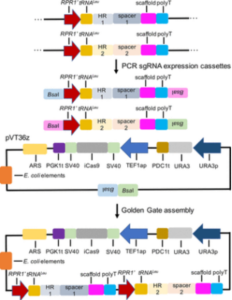
CRISPR/Cas9: The acronym for the gene-editing system known as “clustered regularly interspaced short palindromic repeats and CRISPR-associated protein 9.” Gene editing tools give scientists the ability to change an organism’s DNA. These technologies allow genetic material to be added, removed, or altered at particular locations in the genome. CRISPR is faster, cheaper, more accurate and more efficient than previous genome-editing methods. CRISPR-Cas9 uses a guide RNA fragment to bind both to a target DNA sequence in the genome and to the Cas9 enzyme, which cuts the DNA sequence. The cell’s DNA repair machinery is used to add, delete, or edit the DNA sequence. CABBI scientists have developed CRISPR tools to rapidly engineer new strains of yeasts in their mission to produce biofuels, organic acids, and other biochemicals.
DAYCENT: An ecosystem modeling program, based on the CENTURY biogeochemical model, that uses daily time-steps, or intervals. DAYCENT simulates daily fluxes, or movement, of carbon and nitrogen among the atmosphere, vegetation, and soil. It can operate over several kilometers, such as a county. Key sub-models focus on soil water content and temperature by layer, plant production, and nitrogen gas emissions, among other areas. CABBI’s Sustainability researchers use DAYCENT to profile plant growth and soil dynamics for bioenergy crops to better understand how different agricultural management styles affect soil quality and carbon sequestration.
Eddy covariance: A popular micro-meteorological method to directly observe the exchanges of gas, energy, and momentum between ecosystems and the atmosphere. Using towers outfitted with wind meters, CO2 analyzers, and other equipment, CABBI scientists can measure fluxes in wind turbulence, carbon, and water vapor for various crop ecosystems. They use those readings to compare crops’ water and energy use, carbon cycling, and other factors that determine their sustainability as bioenergy crops.
Watch a video explaining eddy covariance research here.
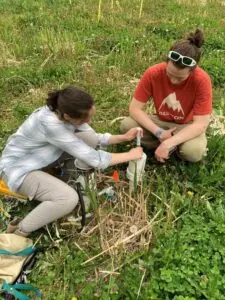
FUN-BioCROP: Acronym for Fixation and Uptake of Nitrogen-Bioenergy Carbon, Rhizosphere, Organisms, and Protection, a new bioenergy model developed by CABBI researchers. FUN-BioCROP simulates the impacts of plant-microbial interactions, soil carbon protection, and mechanistic tillage on soil carbon cycling, showing how differences between bioenergy plants in their root growth, their interactions with microbes in the soil, and how they are grown leads to increases or decreases in soil carbon. This tool can predict the effects of plant choice and agricultural management on soil carbon storage, which has the potential to slow climate change.
Read more about FUN-BioCROP in this news release.
FUN-CORPSE: A soil carbon and nitrogen cycling model at the plot level, combining the FUN (Fixation and Uptake of Nitrogen) model with the CORPSE (Carbon, Organisms, Rhizosphere, and Protection in the Soil Environment) model. FUN-CORPSE looks at what’s happening below ground, predicting the impact on soil carbon and nitrogen cycling from carbon deposited by plants into rhizosphere microbes — those in the narrow region of soil directly affected by root systems. CABBI researchers use the model to analyze the impact of different bioenergy crops on the microbes that control soil carbon cycling; and to determine how crop management practices can affect crops’ “ecosystem services” — their ability to control soil erosion and prevent runoff.
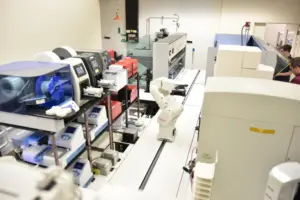
iBioFAB: Acronym for the Illinois Biological Foundry for Advanced Biomanufacturing, a fully automated robotic system for the production and analysis of synthetic biological systems. Described as a “one of a kind living foundry,” the iBioFAB platform uses algorithms and a robotic arm to repeat multiple tasks in an integrated fashion, saving researchers time and labor, providing more reliability, and opening up new possibilities in synthetic biology research. The iBioFAB is housed in the Carl R. Woese Institute for Genomic Biology at the University of Illinois Urbana-Champaign.
MALDI-ToF-MS: Acronym for matrix-assisted laser desorption/ionization time-of-flight mass spectrometry, a screening technique developed by CABBI Conversion researchers to rapidly profile medium-chain fatty acids (MCFAs) in yeast. MCFAs are part of a larger group of free fatty acids that are key components in soaps, industrial chemicals, and fuels. The MALDI-ToF-MS system helps researchers more easily identify which genetically engineered strains of yeasts like Saccharomyces cerevisiae produce higher levels of those MCFAs.
Thermosteam: A software tool that can be used with BioSTEAM, the open-source process simulation library for biorefinery design, simulation, and techno-economic analysis (TEA). Thermosteam can accurately solve mass and energy balances, estimate mixture properties and perform other functions that enable rigorous design and simulations. With this tool, BioSTEAM can be used to evaluate a broader range of biofuels and bioproducts being developed for an emerging bioeconomy. (See related definitions for “BioSTEAM” in this section and “Techno-economic analysis” in Bioenergy Basics.)
